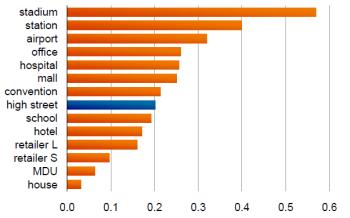 Ever thought about where to site your mobile data connectivity service? I have to admit I’ve not spent much time on it myself. I’d probably come up with a topographical map of where I was providing the service and plan a series of base stations to give me optimum coverage – most bang for my buck. Nothing new really.
Ever thought about where to site your mobile data connectivity service? I have to admit I’ve not spent much time on it myself. I’d probably come up with a topographical map of where I was providing the service and plan a series of base stations to give me optimum coverage – most bang for my buck. Nothing new really.
That’s why the chart on the right makes interesting reading. Provided by Ruckuswireless the graph shows the relative demand density for data usage in Mbps per 10m2 based on type of location. Most of the high demand locations are indoor. The high street, which is where most of us would think of putting in capacity ranks 8th.
Ok the stats come from Ruckus themselves and they want to sell you WiFi hotspots but it is certainly food for thought. Some of the types of locations come with their own specific challenges. Stadia for example only need the connectivity for small periods of time in the calendar. That’s a very business case specific dilemma.
As far as hospitals go I didn’t think they had public WiFi and the last time I went (it’s been some time since I had to cart a kid there) you weren’t allowed to use mobile phones. Happy to be corrected here. If I were in hospital for any length of time I think internet access would be an absolute necessity, if only to look up new and innovative recipes for mince to pass on to chef. I imagine that each bed will take up around 10m2 so Ruckus is effectively saying that each patient in hospital needs around 250kbps.
That sounds a lot – a regular consumer broadband will use roughly 100kbps average traffic (it’s been a while since I looked – it might be more, might be less & it is also dependent on the network). Mind you if you have nothing to do all day other than eat grapes and occasionally lean forward to check the chart at the bottom of your bed maybe bandwidth usage gets hammered. We do have to remember that the figure for consumer broadband probably has several people using the connectivity within a single home. In hospitals there is a high likelihood that a significant proportion of the patients are not internet users at all – those in intensive care, the older demographic etc. Those actually using the bandwidth must therefore be using significantly more than the 250kbps to make up for the beds containing occupants that prefer to do the crossword (Daily Mail, Times, Telegraph etc etc – take your pick).
Not sure where this line of blogging is going? Me neither really. Suffice to say that mobile operators have some decisions to make as to where to roll out connectivity. Indoor coverage is going to be necessary and when it comes to LTE this is likely to be an issue. It will depend on the spectrum used but many operators will probably be looking at a dual technology strategy using WiFi as an offload.
That’s all folks…

2 replies on “Location Location Location – indoor LTE coverage & demand density”
I think the Hospital WiFi is more relevant to the medical staff on-site presumably using whizzy tablet devices and e-records rather than lugging round paper files? 🙂
And recipes for mince 🙂